Razor-sharp risk The tragic end to Adam Johnson’s life in a U.K. rink shocked the hockey world last fall, but the vast majority of NHLers still choose to play without neck protection
Read this article for free:
or
Already have an account? Log in here »
To continue reading, please subscribe:
Monthly Digital Subscription
$0 for the first 4 weeks*
- Enjoy unlimited reading on winnipegfreepress.com
- Read the E-Edition, our digital replica newspaper
- Access News Break, our award-winning app
- Play interactive puzzles
*No charge for 4 weeks then price increases to the regular rate of $19.00 plus GST every four weeks. Offer available to new and qualified returning subscribers only. Cancel any time.
Monthly Digital Subscription
$4.75/week*
- Enjoy unlimited reading on winnipegfreepress.com
- Read the E-Edition, our digital replica newspaper
- Access News Break, our award-winning app
- Play interactive puzzles
*Billed as $19 plus GST every four weeks. Cancel any time.
To continue reading, please subscribe:
Add Free Press access to your Brandon Sun subscription for only an additional
$1 for the first 4 weeks*
*Your next subscription payment will increase by $1.00 and you will be charged $16.99 plus GST for four weeks. After four weeks, your payment will increase to $23.99 plus GST every four weeks.
Read unlimited articles for free today:
or
Already have an account? Log in here »
Hey there, time traveller!
This article was published 25/10/2024 (389 days ago), so information in it may no longer be current.
In terms of hockey gear, it doesn’t look much — a tall, black adjustable collar consisting of cut-resistant fabric and high-impact foam.
Yet, to hear it from the majority of today’s NHL players, it’s a form of kryptonite.
For reasons that can be difficult to comprehend, athletes who are among the toughest on the planet — “warriors” as described by player agent Kurt Overhardt — and who routinely play through injuries and ailments, from broken bones and fractured faces to torn muscles and damaged ligaments, balk at wearing neck guards.
Unfortunately, all the grit, guts and pain tolerance in the world is still not always enough, as witnessed on Oct. 28, 2023 when Adam Johnson suffered a fatal neck wound during a game in England. The 29-year-old from Minnesota lost extensive blood on the ice and was rushed to hospital, where doctors were unable to save him.
“Sometimes we forget that we have knives at the end of our skates,” said Johnson’s best friend, Neal Pionk.
Neal Pionk started wearing a neck guard immediately after his friend’s death.
Johnson’s tragic death was seen as a sentinel moment in the sport, with most leagues that hadn’t already done so moving quickly to make neck guards mandatory.
Among them: The English Ice Hockey Association, the Western Hockey League, the Canadian Junior Hockey League, the IIHF, USA Hockey and, this fall, the ECHL and American Hockey League.
Notably absent is the NHL, although leaders vowed to study the issue and several players took it upon themselves to add protection in the immediate aftermath.
That was the case with Pionk and some of his Winnipeg Jets teammates, several of whom were flown by the organization to attend Johnson’s memorial.
Common sense would suggest it’s a no-brainer, especially with a vivid example of the worst-possible scenario so fresh. Just as helmets and visors have become the norm, a neck guard would seem to be a logical step.
“It’s just such a fast-paced game, bodies are flying everywhere. Accidents happen,” said forward Dominic Toninato, another of Johnson’s friends who began wearing a neck guard with the Jets following the tragedy.
“That’s all you can hope, that it prevents another one, for sure.”
The AHL has mandated neck guards, but Moose forward Dominic Toninato had already added the protective layer last year. “That’s all you can hope, that it prevents another (tragedy).”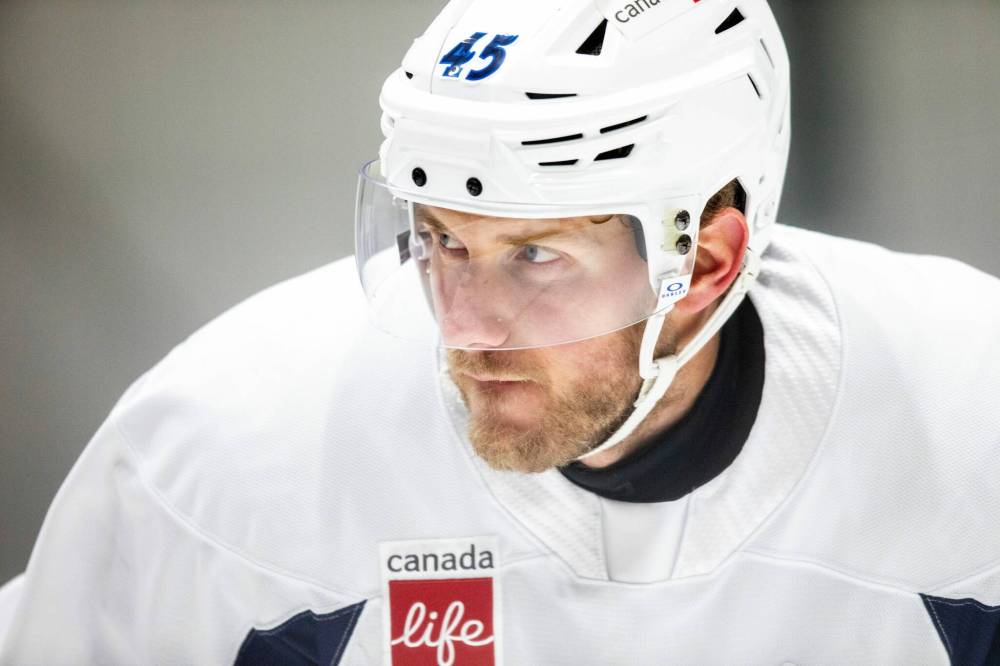
But as we approach the one-year anniversary, a look around the NHL shows it is largely business as usual. The overwhelming majority of skaters are still exposing their bare necks on a nightly basis, and both the league and the player’s association seem content with leaving the decision to players.
It’s a battle between personal choice and player safety at hockey’s highest level — and the former appears to have the edge right now.
That includes the Jets, where Pionk is one of just a handful of players currently wearing a neck guard.
“I just found it was very itchy,” veteran forward Vladislav Namestnikov explained of his decision to stop using one after a few practices last year.
“I understand it’s protective, but I think everyone is different. It’s more of a comfort thing. I’d put it on and everything was just very hot and itchy, for me personally.”
Jets’ Vladislav Namestnikov briefly wore the guard, but found it uncomfortable.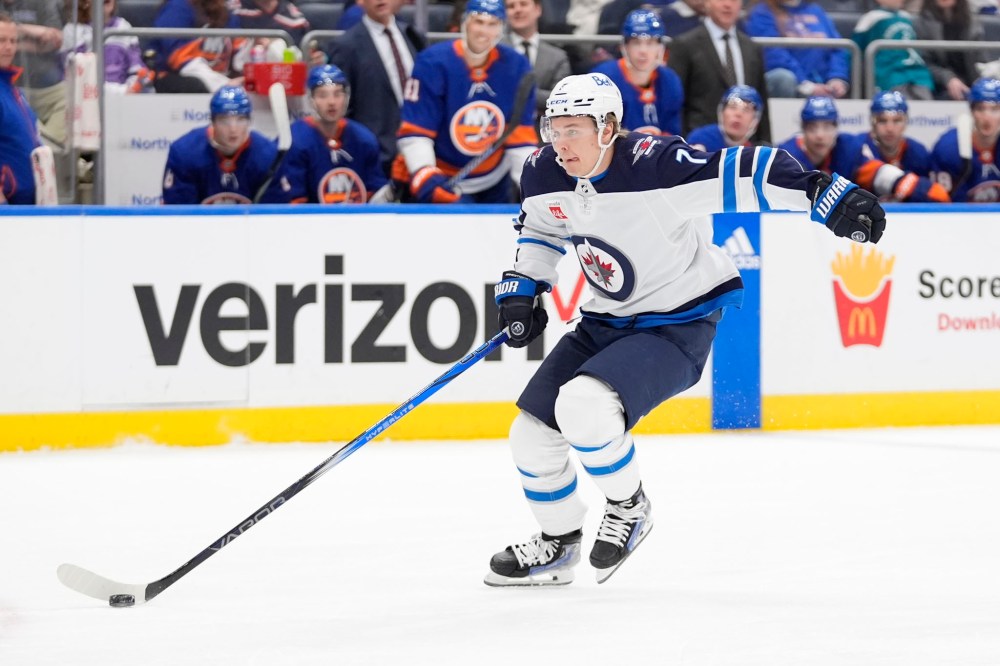
He’s hardly alone. According to a poll of 181 NHL players conducted by The Athletic, 78 per cent stated they don’t want the league to mandate neck guards. With only about three or four players from each team visibly wearing one in recent games we’ve observed, that would seem to be an accurate representation of the current reality.
“I think it will remain an individual choice,” predicted Namestnikov, who added that you “try not to think about” what could happen as a result.
That type of thinking doesn’t come as a surprise to Dr. Adrienne Leslie-Toogood, a Winnipeg-based sports psychologist who is past chair of the Canadian Sport Psychology Association and has worked with professional and amateur athletes in multiple sports for the past three decades.
“When you look at how the brain works, we don’t live with and spend time with those really, tough things (that occur),” she said.
“It would be very hard for us to function. Like we experience a lot of really tough things in our lives, so we kind of deal with them, but then we get back to dealing with our day-to-day.”
Whether it’s speeding, texting while driving, smoking cigarettes, abusing alcohol and drugs or not wearing a helmet while cycling or riding a motorcycle, there’s no shortage of everyday examples of people doing things they know aren’t good for them.
“From a human perspective, humans don’t necessarily like being told what to do.”–Dr. Adrienne Leslie-Toogood
“From a human perspective, humans don’t necessarily like being told what to do,” said Leslie-Toogood. “We like it when we’re provided options.”
In hockey, that may mean not wearing a visor — there’s a handful of players whose birthdates allow them to play without one — or even things that are not currently mandated in the NHL such as wrist, ear and neck guards, consequences be damned.
“When you look at what it takes to become a professional athlete, there’s so much passion, and you have to make a lot of decisions and override a lot of things,” said Leslie-Toogood.
“And you do have your habits and tendencies and processes, right? And athletes really make a lot of choices that prioritize their sport over — gosh, there’s just so many examples. You know, you look at the literature around concussions.”
In that sense, it’s tough to change what’s essentially ingrained in their DNA.
“Warriors get ready for battle. They should wear every piece of equipment that helps benefit them from a safety standard.”–Player agent Kurt Overhardt
“They will push themselves to limits that don’t make sense to a lot of other humans, and that’s why those humans aren’t high-performance athletes,” she said.
“We absolutely love that they’re willing to do that. We love watching it. And they aren’t necessarily thinking of their safety. They’re not cautious, because every time they go out there, they have to push the limits of what’s possible and what they do, and that’s also their fuel and how they’re wired and it’s what they love doing.”
Overhardt, who represents several of the NHL’s biggest stars, said he often speaks with his clients about the importance of protecting themselves, noting he’s had many players who have had careers cut short by skate cuts.
Former defenceman Kevin Bieksa, for example, suffered two different Achilles cuts that cost him a chance at playing in 1,000 games.
“Warriors get ready for battle. They should wear every piece of equipment that helps benefit them from a safety standard,” said Overhardt.
“For better, for worse, it’s an evolution for health and safety. And the one thing about our game is it certainly continues to get quicker.
“The edge work that these players have, and the speed that they have and the power they have, it’s a significantly different game than it was 10 years ago. It’s probably an unrecognizable game to what you saw 30 years ago. I think we always like everything else in our lives, we have to keep up with the times.”
“Most are not going to wear them unless they’re told to wear them.”–Player agent Kurt Overhardt
Admittedly, that advice often goes in one ear and out the other.
“Most are not going to wear them unless they’re told to wear them,” he said.
Which raises a question: at what point to players need to be protected from themselves by having the neck guard decision taken out of their hands?
While speaking with media earlier this fall at an NHL event in Las Vegas, deputy commissioner Bill Daly was asked if a day will come when the league steps in.
“I hope so, on some basis. I think we’re moving in that direction,” he said, noting the experiment in the AHL which is being watched closely, the way previous rule and equipment tweaks have been tested out in the past.
“Look, they’re the highest level of the game. NHL players don’t want to be told necessarily what to do and what not to do, particularly when it could affect performance on some basis. We did propose a mandatory rule, but we clearly understand where the union is coming from and some of the difficulties they have with their constituents. It’s a process.”
Meanwhile the NHLPA said in a statement the league and the union work jointly on ensuring players have the necessary information to make informed choiced about their equipment.
Its members, however, “continues to feel strongly that wearing cut-resistant equipment is a matter of individual preference.”
Pionk said every player likely has had a close call or two in their career, and there’s no question the issue hits close to home in Winnipeg.
“I had a skate get me in the chest one time, that’s a foot away (from his neck),” he said.
Vegas Golden Knights centre Chandler Stephenson (20) helps Morgan Barron (36) after Barron's face was cut by a skate in April 2023.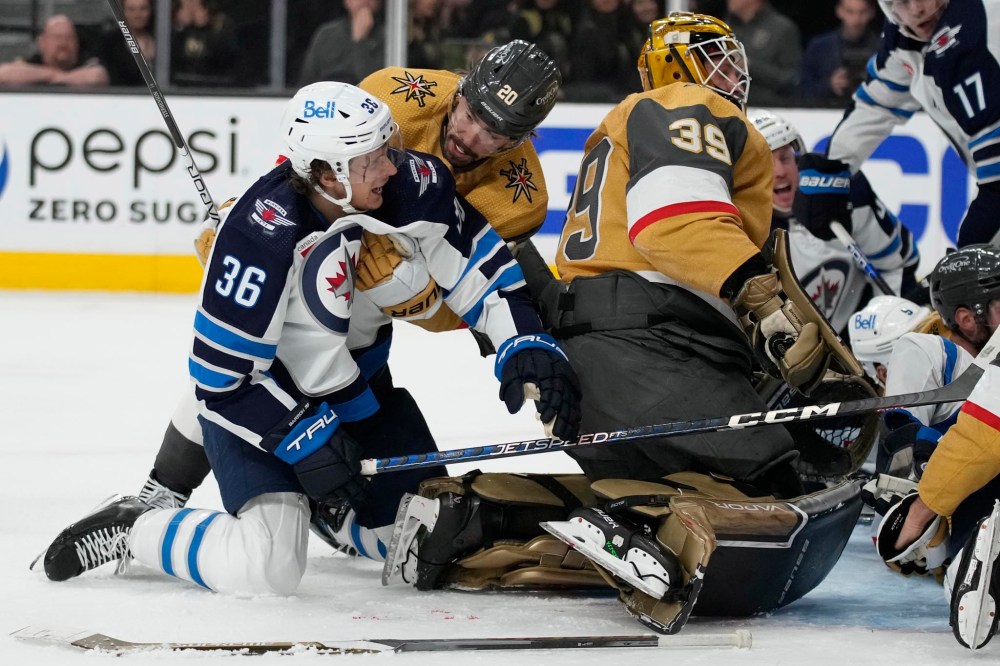
Last April, defenceman Brenden Dillon had his hand stepped on by a skate during a scrum in a playoff game against the Colorado Avalanche, resulting in a nasty injury that sidelined him for the rest of the series.
Jets forward Morgan Barron suffered a huge cut to his face during a playoff game against Vegas two years ago when the skate of then-Golden Knights goaltender Laurent Brossoit caught him under the visor near his eye, resulting in more than 70 stitches.
Former Jets defenceman Zach Redmond had his femoral artery sliced by teammate Antti Miettinen’s skate during a practice in 2013. He lost half his body’s blood and needed emergency surgery to repair arteries, veins, tendons and muscles, along with about 200 stitches.
Incredibly, most goaltenders don’t wear neck guards either, despite being subjected to plenty of crease traffic and errant skates, sticks and pucks. Buffalo Sabres goaltender Clint Malarchuk had his carotid artery and jugular vein cut by a skate in 1989. One of his teammates at the time was current Jets head coach Scott Arniel.
Neck guards can also protect against pucks, especially with players now shooting harder than ever. Montreal Canadiens forward Trent McCleary nearly died in 2000 after taking a shot to the throat, which required an emergency tracheotomy.
“I can’t believe we don’t have more incidents that are as tragic as last year,” a league source told the Free Press, referring to Johnson.
“I can’t believe we don’t have more incidents that are as tragic as last year.”
Among members of the Jets’ AHL club, the neck guard mandate has gone over without a hitch.
“There’s no issues. Guys have been good about it. There’s always things you can alter with your equipment, but I think everyone has been good,” said second-year Manitoba Moose forward Danny Zhilkin.
The 20-year-old, who was born in Russia but has spent most of his life in Canada, began wearing a neck guard in minor hockey, then had to wear one while playing junior on the Ontario Hockey League.
He turned pro last season and initially shed the protective piece, but put it back on immediately after Johnson died.
“My family kind of put a little bit of pressure on me to keep myself safe. They don’t want to see me hurt,” he said.
Zhilkin wore it the rest of the year and now has no choice, which is fine by him.
“I think it was only a few of us who started to wear it right after the accident. But I think it’s a huge thing, for sure, just being safe and having the confidence when you’re on the ice that nothing is going to happen to you,” he said.
Moose forward Danny Zhilkin said the guard adds a layer of confidence.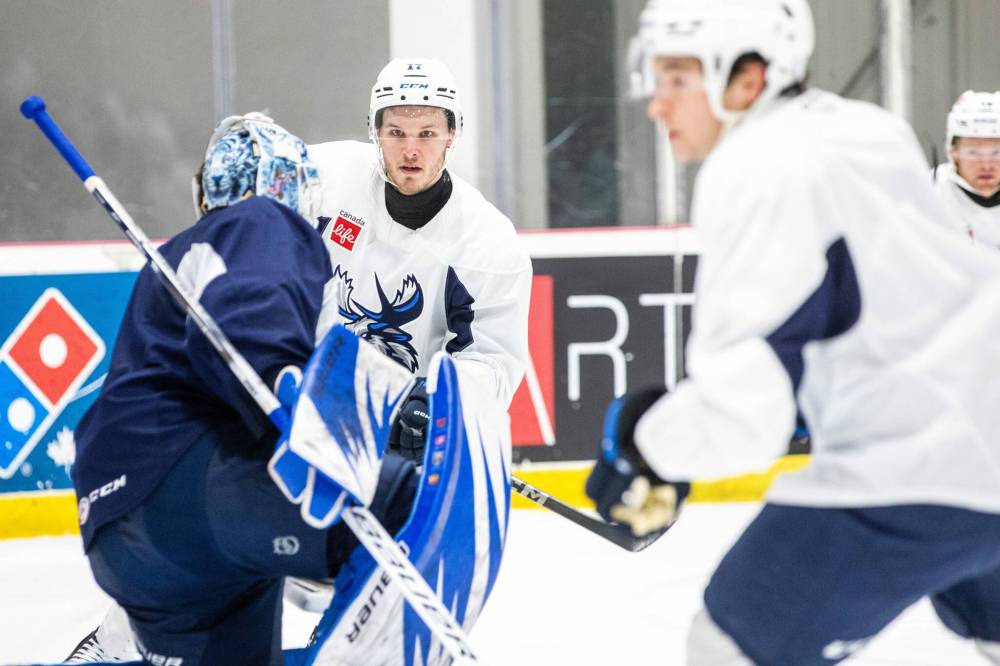
Toninato continued wearing a neck guard when he was sent down to the Moose last year. He has started this season in the AHL where he admits to having mixed feelings about the mandate despite his close connection to Johnson.
“Obviously, you’re really happy that everyone is being protected, but at the same time, it’s tough. Guys want to make decisions for themselves. Where’s the fine line?” said Toninato.
While comfort is often cited as a cause, the 30-year-old said habit is a big one, too — especially for American-born players like himself who never had to wear one growing up, unlike Canadian kids where it has been mandated for the past three decades.
“Guys are so used to doing the same routine, doing the same stuff. I mean, you’ve got guys wearing some of the same gear for 10 plus years, right?” said Toninato. “I think it might be feel and how they’ve always played the game and what they’ve worn.”
Peer pressure can be a powerful thing, but Pionk said he isn’t going around the Jets room preaching to teammates about neck protection despite how much the Johnson tragedy hit home.
“I think the technology is getting a lot better, even in the last year. Imagine five years from now what the options will be for neck guards.”–Neal Pionk
“I’m OK with (the lack of a mandate) right now,” he said.
“We’re at the highest level, we can make our own choice. Guys are educated on it. We have a tutorial on it every training camp, so I’m OK with it. Will it come around eventually? Maybe. I think the technology is getting a lot better, even in the last year. Imagine five years from now what the options will be for neck guards.”
To that extent, Pionk said his current garb, which is essentially a thin turtleneck-style undershirt made by the Warroad company in Minnesota — owned by Washington Capitals forward T.J. Oshie — is a “huge improvement from last year.”
“The first one I wore last year was extremely hot. It was so hot. I got used to it eventually. But then when I put this one on, this is paper-thin and this covers your wrist and this covers your neck,” he said.
“And that’s only in a year. In five years from now, and if there’s a ton of options, maybe they’ll revisit the idea. But that’s kind of where I see it.”
Although hockey players have no shortage of pride, Pionk doesn’t believe personal ego is standing in the way.
Photos of Adam Johnson line the ticket window booth at the Hibbing Memorial Building, in Hibbing, Minn. The Hibbing native suffered a fatal neck wound during a game in England on Oct. 28, 2023. (Mark Sauer /The Mesabi Daily News via AP)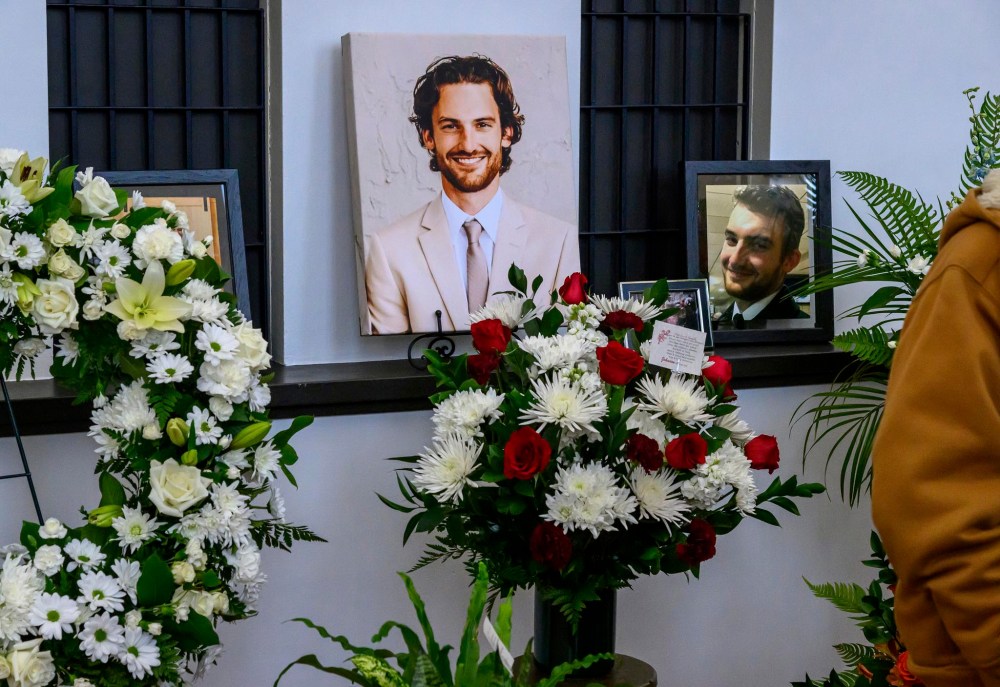
“It’s a comfort thing. I grew up in USA hockey and we didn’t have neck guards, but we had to wear mouth guards. When I went to Thunder Bay to play hockey, the whole team had to go to the pro shop store to get neck guards,” he said.
“And vice versa, when the Canadians came down and played in Duluth, they all had to go get mouth guards. We never ever wore neck guards. Now, have I gotten used to it? Yeah. I don’t even notice it anymore. I don’t notice it all.”
Pionk, who spent extensive time with Johnson’s family during the summer and continues to grieve such an immense loss, hopes some light will eventually come out of this darkness — even if it may still be tough to see right now.
“They would probably take some comfort knowing that guys were starting to protect themselves and make themselves more aware,” he said.
mike.mcintyre@freepress.mb.ca
X: @mikemcintyrewpg

Mike McIntyre is a sports reporter whose primary role is covering the Winnipeg Jets. After graduating from the Creative Communications program at Red River College in 1995, he spent two years gaining experience at the Winnipeg Sun before joining the Free Press in 1997, where he served on the crime and justice beat until 2016. Read more about Mike.
Every piece of reporting Mike produces is reviewed by an editing team before it is posted online or published in print — part of the Free Press‘s tradition, since 1872, of producing reliable independent journalism. Read more about Free Press’s history and mandate, and learn how our newsroom operates.
Our newsroom depends on a growing audience of readers to power our journalism. If you are not a paid reader, please consider becoming a subscriber.
Our newsroom depends on its audience of readers to power our journalism. Thank you for your support.
History
Updated on Friday, October 25, 2024 2:43 PM CDT: Corrects typo in subheadline.









